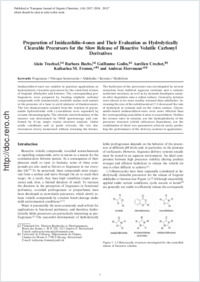Preparation of imidazolidin-4-ones and their evaluation as hydrolytically cleavable precursors for the slow release of bioactive volatile carbonyl derivatives
- Trachsel, Alain Firmenich SA, Division Recherche et Développement, Genève, Switzerland
- Buchs, Barbara Firmenich SA, Division Recherche et Développement, Genève, Switzerland
- Godin, Guillaume Firmenich SA, Division Recherche et Développement, Genève, Switzerland
- Crochet, Aurélien Université de Fribourg, Département de Chimie, Switzerland
- Fromm, Katharina M. Université de Fribourg, Département de Chimie, Switzerland
- Herrmann, Andreas Firmenich SA, Division Recherche et Développement, Genève, Switzerland
-
22.03.2012
Published in:
- European Journal of Organic Chemistry. - 2012, no. 14, p. 2837–2854
English
Imidazolidin-4-ones are suitable in practical applications as hydrolytically cleavable precursors for the controlled release of fragrant aldehydes and ketones. The corresponding profragrances were prepared by treating aliphatic carbonyl compounds with commercially available amino acid amines in the presence of a base to yield mixtures of diastereomers. The two diastereomers isolated from the reaction of glycinamide hydrochloride with (–)-menthone were separated by column chromatography. The absolute stereochemistry of the isomers was determined by NMR spectroscopy and confirmed by X-ray single crystal structure analysis. Under acidic conditions and in protic solvents, the two diastereomers slowly isomerized without releasing the ketone. The hydrolysis of the precursors was investigated by solvent extraction from buffered aqueous solutions and a cationic surfactant emulsion, as well as by dynamic headspace analysis after deposition onto a cotton surface. Generally, ketones were shown to be more readily released than aldehydes. Increasing the size of the substituents at C-5 decreased the rate of hydrolysis in solution and on the cotton surface. Glycinamide-based imidazolidin-4-ones were more efficient than the corresponding oxazolidin-4-ones or oxazolidines. Neither the release rates in solution, nor the hydrophobicity of the precursor structure (which influences deposition), nor the combination of these two parameters allowed easily predicting the performance of the delivery systems in application.
- Faculty
- Faculté des sciences et de médecine
- Department
- Département de Chimie
- Language
-
- English
- Classification
- Chemistry
- License
-
License undefined
- Identifiers
-
- RERO DOC 29130
- DOI 10.1002/ejoc.201200081
- Persistent URL
- https://folia.unifr.ch/unifr/documents/302398
Other files
Statistics
Document views: 191
File downloads:
- pdf: 511
- Supplementary material: 183

